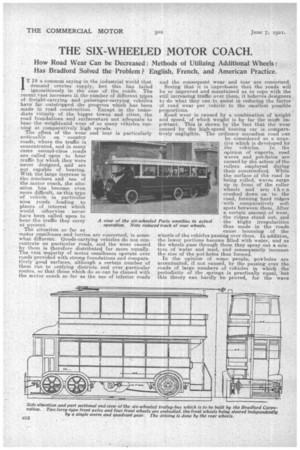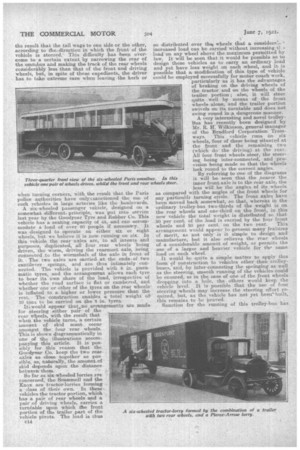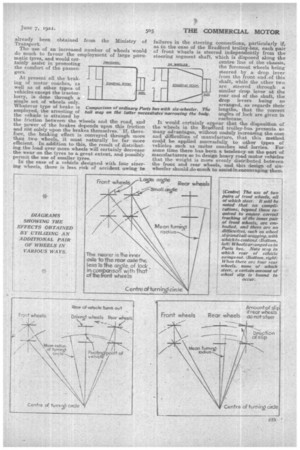THE SIX-WHEELED MOTOR COACH.
Page 12

Page 13

Page 14

Page 15

If you've noticed an error in this article please click here to report it so we can fix it.
How Road Wear Can be Decreased : Methods of Utilizing Additional Wheels : Has Bradford Solved the Problem ? English, French, and American Practice.
IT IS a common saying in the industrial world that demand creates supply, but this has failed ignomihiously in the case of the roads. The recent vast increases in the number of different types of.' freight-carrying and palsenger-carrying vehicles have far -outstripped the .progress which has been made in. road construction. Except in the immediate 'vicinity of the . bigger towns . and .cities, the road foundations_ and surfacesfire not adequate to bear the weight4and wear of so Many vehicles running at comparatively high speads.:
The. effect of the .wear and tear is particularly noticeable on ' country roads; where the traffic is concentrated, and in many cases second-class .roads .are called upon to bear traffic for which they were never designed, and are not capable of bearing. With thelarge increase in the numbers and use of the motor coach, the situation has become even more difficult, aa'this type of vehicle in particular uses roads leading to places of interest which would otherwise • never have been called upon to bear the traffic they carry at present. The situation so far as motor omnibuses and lorries are concerned, is somewhat different. Goods-carrying vehicles do not concentrate on particular roads, and the wear caused by them is therefore .distributed far more equally. The vast majority of motor omnibuses operate over roads provided with strong foundations and comparatively good surfaces, although a certain number of them run to outlying districts and over particular routes, so that. those which do so can be classed with the motor coach so far as the use of inferior roads and the consequent. wear and tear are concerned. Seeing that it is improbaole that the roads will be so improved and maintained as to cope with the still increasing traffic over them, it behoves designers to do what they can to assist in reducing the factor of road wear per vehicle to the smallest possible proportions. Road wear is caused by a combination of weight and speed, of which weight is by far the moile important. This is shown by the fact that the wear caused by the high-speed touring car is, comparatively negligible. The ordinary macadam road can be considered as a negative which is developed by thevehicles. In the opinion of experts, road waves and pot-holes are caused by the action of the rollers employed during their construetiort. While the surface of the road is being rolled, waves surge up in front of the roller wheels and are then crushed down on to the road, forming hard ridges with comparatively soft spots between them. After a certain amount of wear,, the ridges stand out, and the plight irregularities thus made in the roads cause bouncing of the wheels of the vehicles passing over them. In addition, the lower portions become filled with water, and as the wheels pass through them they spray out a mixture of water and mud, and consequently increase the size of the pot-holes thus formed.
In the opinion of some people, poS holes are accentuated, if not caused, by the passing over the roads of large numbers of vehicles in which the' periodicity of the springs is practically equal, but this theory can hardly be proved, for the wave crests are usually between 2 ft. and 2 ft. 6 ins. apart, whereas a vehicle, the pAiodicity of the springs on which averages 100 complete vibrations per minute, travelling at a speed of 12 m.p.h. traverses 10 ft. 6 ins, during one complete spring vibration, .so that, for this theory to hold good, the wave crests or pot-holes should be spaced this distance apart. At the same time, it is quite possible that the action of the springs has a lot to do with the wear, and when designing a vehicle with more than two axles, it may be found possible so to arrange these as to break up the harmonic vibrations caused by the springs. In the Grompton-Tapp three-axle road roller the axles were unequally spaced in order to embody this principle, and to prevent the formation of road waves whilst the roads were being constructed. • There are several ways of reducing road wear, but not all of these are commercial propositions. The simplest method would be to limit the weight of all 'vehicles, but it is well known that it is not a. paying proposition to split up a large quantity of goods over more carrying units than is absolutely necessary, as the cost per ton-mile is thereby considerably increased ; as a matter of fact, the tendency is quite in the other direction, as the Minister of Transport, in a speech made some little time ago, pointed out. The necessity is for hauling bigger loads with each power unit rather than increasing the number of such units.
The second way of reducing road wear is to decrease the load carried by each wheel without reducing.the weight of the whole vehicle. This can only be done by increasingthe number of wheels per vehicle, and already several more or less successful attempts have been made in this direction.
At present there is running in Paris an experimental motor omnibus provided with six wheels. This vehicle so .far as its front and driving wheels are concerned, is practically of standard dekgn, and it is altered by making the chassis longer and carrying the overhang thus obtained by means of an extra pair of wheels carried on stub axles, as in the case of the front wheels, and connected to the front steering gear. The whole of the braking, which is done through the driving wheels, does not appear to be highly satisfactory, as the increased weight of the whole vehicle does not increase the weight on the driving wheels, and therefore the friction between them and the road remains the same as in the case of the four-wheeled omnibus.
The system also presents other disadvantages, The vehicle uses the driving wheels as a fulfirum, with
the result that the tail wags to one side or the other, according to theedireetion in which the front of the vehicle is steered: This difficulty has been overcome to a certain extent by narrowing the rear of the omnibus and making the track of the rear wheels considerably less than that of the front and driving wheels, but, in spite of these expedients, the driver has to take extreme care when leaving the kerb or when turning corners, with the result that the Paris police authorities have onlyesanctioned the use of such yehieles in large arteries like the boulevards.
A six-wheeled passenger vehicle, designed on a somewhat different: principle, was put into service last year by.the Goodyear Tyre and Rubber Co. This vehicle has a: seating capacity of 44, and can accommodate a load of over 80 people if necestaey. It was designed to operate on either six or eight wheels, but we believe it is now. running on six. In this vehicle the rear• axles are, to all intents end purposes, dupliceted,. all four rear wheels -being driven, the worm, driving the rearmost axle, being connected to the wermshaft of the axle in front of it. The two axles are carried at the ends, of two cantilever springs, and are thus intimately connected. The vehicle is provided. with 8 in. pneumatic tyres, and the arrangement allows each tyre to bear its 'own share of the load, irrespective of whether the road surface is flat or cambered, and whether-one. or other of the tyres on the rear wheelsis inflated to a higher or lower pressure than the rest. The construction enables a total weight of. 10 tons to be. carried on the 8 in. tyres.
It.would appear that...noarrengements are made for steering either pair of the rear wheels, with the result that when the vehicle turns, a certain amount of skid must, occur amongst the four -rear wheels. This is shown diagrammatically in one of the, illustrations accompanying this article. It is possibly for this reason that the Goodyear Co. keep the two rear axles as elose together as possible, as, naturally, the amount of skid depends upon the distance betweenthem.
Bo far as 'six-wheeled lorries ere
• concerned, the Scammell and the Knox are tractor-lorries forming a nags of their own. In theee, vehicles the tractor portion, which has a pair of rear wheels and a, pair of driving wheels, carries a turntable upon which the front portion of the trailer part of the vehicle pivots. The load is thus
el4
so distributed over thel. wheels that a considerale increased load can be carried without increasing ti load• on any wheel above' the. maximum permitted by law. It will be seen that it would be possible so to design these vehicles as to carry an ordinary load and yet have less weight on each wheel, and it is possible that a modification of this type of vehicle could be employed successfully for motor coach work,
particularly as it has the advantages of braking on the driving wheels of the tractor and on the wheels of the trailer portion ; also, it will steer quite well by means of the front wheels alone, and the trailer portion swivels on its turntable and does not swing round in dangerous manner.
A very interesting and novel trolley
hits has ,recently been designed by Mr. R. H. Wilkinson, general manager of the Bradford Corporation Tramways. This vehicle runs on six wheels, four of these being situated at the front and the remaining two (which do the driving) at the rear. All four front wheels steer, the steering being inter-connected, and pro
, vision being made so that the wheels lock round to the correct angles.
By referring to one of the diagrams it will be seen that the nearer the inner front axle is to the rear axle, the less will be the angles of its wheels as compared with the angles of the front wheels for any particular turning circle. The front axles have been moved back somewhat, so that, whereas in the ordinary trolley-bus two-thirds of the weight is on the rear wheels and one-third on the front, in this new vehicle the total weight is distributed so that. 50 per cent. of the load is carried by the four front wheels and 50 per cent. on the two rear. This arrangement would appear to present many features of merit, as not onlyis it simple to design and manufacture, but it. also relieves the rear wheels of a considerable amount of weight, or permits the use of a larger and heavier vehicle for the. same load on each wheel.
It would he quite a simple matter to apply this form of construction to vehicles other than trolleybuses, arid, by inter-connecting the springing as well as the steering, smooth running of the vehicles could be ensured, as in the case of one of the front wheels dropping into a hole, the others would keep the vehicle level. It is possible that the use of four steering wheels may increase the steering effort required, but, as the vehicle has not yet been' built, this remains to be proved. Sanction for the running of this trolley-bus has already been obtained from the Ministry of Transport.
The use of an increased number of wheels would do much to favour the employment of large pneumatic tyres, and would certainly assist in promoting the comfort of the passengers.
At present all the. braking of motor coaches, as well as of other types of vehicles except the tractorlorry, is done through a single set of wheels. only-. Whatever type of brake is Comparison of ordinary Paris employed, the arresting of tail wag on the latter necessi the vehicle is attained by
MAII0Aqb
the friction between the wheels and the road? and the power of the brakes depends upon this friction and not solely upon the brakes themselves. If, therefore, the braking effect is conveyed through more than two wheels, it must naturally be far more efficient In addition to this, the result of distributing the load over more wheels will certainly decrease the wear on the tyres to a great extent, and possibly permit the use of smaller tyres. In the case of a vehicle designed with four steering wheels, there is less risk of accident owing -to
failures in the steering connections, particularly if, as in the case of the Bradford trolley-bus, each pair of front wheels is steered independently from the steering segment shaft, which is disposed along the centre line of the chassis, the foremost wheels being steered by a drop lever from the front end:of this ' shaft, while the other two are steered through a similar drop lever at the
PS rear end of the shaft, the drop levers being so arranged, as regards their lengths, that the correct totes narrowing the body. angles of lock are given in
bus wi h six-wheeler. The each, case.
/t would certainly appear that the disposition of the wheels in the Bradford trolley-bus presents so many advantages, without unduly increasing the cost and difficulties of manufacture, that this method could be applied successfullyto ,other types of vehicles such as motor coaches and lorries. For some time there has been a tendency on the part of manufacturers so to design heavy roadn3otor vehieles that the weight is more evenly distributed. between the front and rear wheels, and this design of sixwheeler should,do much to assist in encouraging them.
































